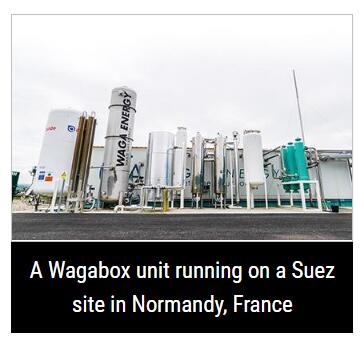Welcome to Sino Bearings web
24x7 HOTLINE:+86-28-81454188

 NEWS
NEWS
New technology is upgrading landfill gas into renewable natural gas
Novel technology has been developed that makes it possible to produce grid-compliant renewable natural gas (RNG) from landfill gas, a by-product of waste management. This technology, known as Wagabox, turns a massive source of atmospheric pollution into clean, local and renewable energy. By recovering a by-product of waste management, the French company Waga Energy produces the most cost-competitive RNG possible, and makes RNG an affordable substitute for fossil natural gas.
In February 2021, Waga Energy signed a contract with Ferrovial Servicios group, a leading global service operator, to install a Wagabox purification unit at the Can Mata landfill, one of Spain’s largest landfill sites, near Barcelona.
This unit will be commissioned in 2022. It will treat up to 2,200m3/h (1,365 scfm) of landfill gas and inject 70GWh (240mBtu) of RNG per year into the gas network of the Spanish operator Nedgia, which is equivalent to the annual energy consumption of 14,000 Spanish households or a fleet of 200 lorries. This innovative project will avoid the emission of 17,000 tonnes of CO2 per year by substituting renewable gas for natural gas.
This is the first ever landfill gas injection project to be financed by a long-term power purchase agreement (PPA) in Europe. This method of financing is common for renewable electricity projects, but rarely used for green gas projects, generally unable to provide buyers with a competitive price over the long term. This “RNG purchase agreement” has been made possible thanks to the proven efficiency of the Wagabox technology, combined with its creator’s broad expertise in landfill gas injection projects.
The challenge of upgrading landfill gas to renewable natural gas
Upgrading landfill gas into grid-compliant RNG is a real challenge. Landfill gas is a complex mix of different gases created spontaneously by the action of microorganisms within the landfill. It is made of methane (CH4), carbon dioxide (CO2), nitrogen (N2), oxygen (02) and various pollutants. As landfill waste is not sorted, the composition and flow rate of landfill gas are highly variable and unpredictable – methane levels can jump from 35 to 55% on the same day due to weather conditions.
“Methane is an energetic gas: it is the main constituent of the natural gas we use for heating, cooking and transportation. Therefore, recovering this methane to inject it into the gas grids is a common-sense idea: it contributes in substituting fossil natural gas, while curbing a major source of greenhouse gas emissions”, explains Mathieu Lefebvre, co-founder and CEO of Waga Energy.
Methane molecules must be separated from others compounds to obtain RNG. This is a difficult process: the mixture of methane and oxygen can be explosive in certain proportions; nitrogen, oxygen and methane are molecules of similar sizes that are extremely difficult to separate by filtration; plus, landfill gas contains a multitude of pollutants (VOCs, BTEX, ammonia, siloxanes, etc) that must be removed to comply with grid specifications.
The few existing solutions, mainly in the USA, combine several technological building blocks from various suppliers. They are expensive, complex and offer poor methane recovery rate. Above all, they are unable to recover methane from landfill gas with high air concentration.
Ten million cubic metres of methane lost every hour in current landfill gas processes
The most commonly used solution for upgrading landfill gas is combined heat and power (CHP), despite the fact it is not very efficient. CHP offers low power yields, and the heat can rarely be exploited as landfill sites are far from urban areas. CHP plants are mainly deployed for branding reasons and social acceptance of landfills and are not profitable without government subsidies. Most landfills in the world simply release the gas into the atmosphere, contributing to climate change. In some countries, landfill operators have to collect it and flare it.
“Ten million cubic metres of energetic gas are lost every hour in landfills around the world. Such a waste of energy is unbearable as we are facing consequences of global warming. Our mission is to recover this energetic gas that would otherwise be lost,” says Lefebvre.
The Wagabox solution uses cryogenics to overcome all the challenges that have previously hindered the use of landfill gas as a substitute for fossil natural gas. It guarantees high-quality RNG regardless of air gas concentration, adapts to all gas variations, and delivers three times more energy than CHP.
There are 10 Wagabox units up and running. with five more under construction.
The technology combines membrane filtration for CO2 removal with cryogenic distillation for nitrogen and oxygen removal.
The membrane filtration process used is similar to that anaerobic digestion (AD) plants. The cryogenic distillation process, however, is new. Landfill gas is cooled to 112K (–116°C) to convert methane in liquid phase while nitrogen and oxygen remain in the gaseous phase. Methane is recovered by gravity at the bottom of a distillation column and vaporised for grid injection.
The system guarantees grid-compliant RNG even from a landfill gas with up to 30% air gases concentration. A unit can be plugged into any landfill gas collection network, in place of a flare or a CHP engine. The exit-end pipe is connected to an injection station operated by the local gas grid operator. Once commissioned, the unit injects RNG 24/7, with uptime in excess of 95%. Wagabox is a fully automated plant, which is remotely monitored through a command-and-control system.
“Our objective is to commission 100 units worldwide by 2025 to have a significant impact on climate change,” concludes Lefebvre.